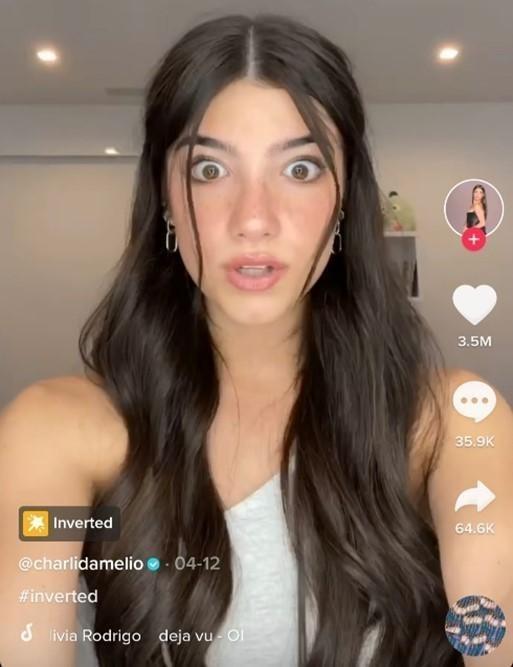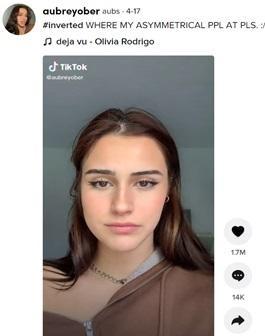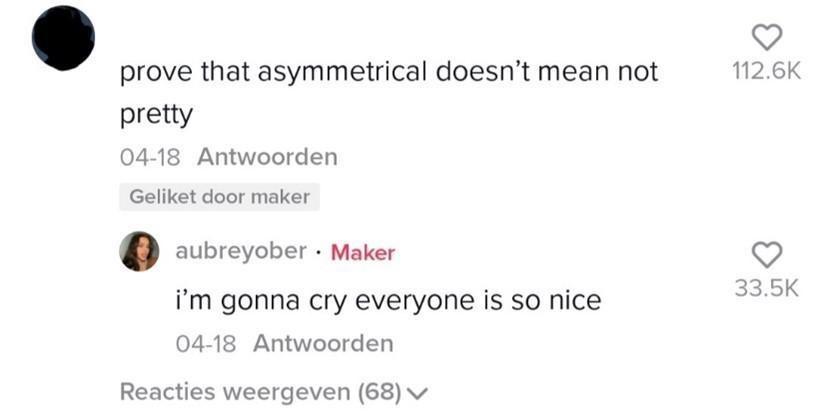
TikTok's inverted filter: debunking symmetry as beauty standard
In April 2021, another TikTok trend emerged and went viral: show the public how symmetrical your face is using the inverted filter. The inverted version of you is supposed to be your ‘unflipped’ image, which is the way everyone else would perceive you. By using the sound of a sample of the song Déjà Vu by Olivia Rodrigo, together with using the inverted filter in a TikTok video, people can participate in the trend. Trends become trends because they fit in the logic of being on social media: people want to fit in and want to be part of something popular they see happening.
It is a cultural belief that facial symmetry is a feature of beauty that has been maintained for centuries. People associate it with genetic quality and visual attractiveness, especially in women. Yet, it is also a highly unrealistic beauty standard: only around 2% of the population has a symmetrical face (Fink et al., 2005). In the case of the other 98%, the inverted image does not correspond with the familiar face in the mirror. Therefore, the filter accentuates people's asymmetry and this can make especially young people insecure.
Nevertheless, a lot of people wanted to give the trend a try and find out if they belong to the 2%. As of October 7th, 2021, the filter has been used in 254K videos. When entries to the trend were on everyone’s For You Page in April 2021, it was noticeable that the most popular videos were from the well-known TikTokers and influencers with symmetrical faces, like Addison Rae and Charli D’Amelio.
In this paper, I will be doing discourse analysis on two TikTok entries to the inverted filter trend: a video of the micro-celebrity Charli D’Amelio and a TikToker named @aubreyober who gives her twist on the trend. The focus of this paper will be on the latter. In analyzing discourse, any discursive or semiotic resource used in the video to communicate something is important to look at. Discourse is always dialogical and, therefore, the top comment of @aubreyober’s TikTok, illustrating the audience’s uptake, will be analyzed as well. By connecting the TikToks, the trend's social meaning can be explained and something can be said about recontextualization.
Therefore, my research question will be: What does @aubreyober’s TikTok video indicate about the social/indexical meaning of the inverted filter trend?
Conceptual approaches: multimodality and indexicality
Two conceptual approaches, multimodality and indexicality, will be applied in the analysis of the two TikTok videos.
The first concept that is part of the framework is multimodality. Modalities are defined and invested in the affordances of the platform and interact with each other. In TikTok videos, different varieties of modalities can be detected: text (caption), visuals, sound, attitude, etc. Viewers of TikTok videos combine different activities that emphasize its primary visual character: ‘reading’, ‘looking at’, and synthetic as well as analytic decodings (Kress & van Leeuwen, 1996). Multimodality helps unravel the socio-cultural relationship between the use of semiotics and the production of knowledge. A text like a TikTok video produces meaning and little pieces of information can be detected, all adding to the broader meaning. This meaning fits in society and gives the author of the text a social identity. In other words, the maker of a TikTok video uses multimodal signs to communicate something and perform a certain identity (Blommaert, 2020).
Having identified all the modes from the two TikTok videos, the social or indexical meaning can be deduced. In a trend, a speech community emerges, where people display shared patterns of indexical meaning-attribution. These are often adherence to social-semiotic norms and rules. So, by taking an indexical approach, the trend’s embedded social norms and roles can be explained which reveal the trend’s message (Blommaert, 2005).
The analysis

Figure 1. @charlidamelio’s version of the inverted filter trend
This TikTok of popular influencer @Charlidamelio was posted on the 12th of April 2021, watched 35,7 million times, and received 3,5 million likes, as can be seen in figure 1.
Let’s look at the different modes in this video: text (caption), the choreography of gesture, music, clothing/appearance, and facial expressions. Charli activated the filter, inserted the hashtag as her only caption, and put the ‘Déjà Vu' sound over her video. Her face is exactly in the middle and barely changes as she taps the screen to flip her face.
Paying attention to the choreography of gesture, appearance, and music, she is lip-syncing. Charli is thus interacting with the viral sound of the video. She smiles playfully at the camera and looks quite confident. She wears a top, has done her makeup and wears earrings, and has done her hair in a middle part which adds to her symmetry. It looks like she filmed the video in her house, but made sure the lighting was good. It can be argued that she prepared herself to make this TikTok and is performing a certain identity of someone that knows exactly what she is doing, which makes sense as she does this for a living.
Her video played a big part in the trend’s popularity. The video was posted around the time when the trend started to become popular. She has more than a hundred million followers on TikTok that got to see it first. As her many followers interact with her video, it gets recommended on other users' For You page and, consequently, goes viral and reaches a large audience. Many of her followers are young girls who are impressionable and most likely look up to her. They admire her or are even jealous that Charli’s face is that symmetrical. The three top comments said the same: ‘How are you so symmetrical?’. It seems that these comments insinuate something else: ‘how are you so perfect?’ and ‘Tell us how to look more like you!’

Figure 2. Screenshot of @aubreyober's video
Like Charli, TikToker @aubreyober used the hashtag #inverted, the Déjà Vu sound for her video to fully participate in the trend (figure 2). Since her version was posted five days later than Charli’s video, Aubrey is likely to have seen the trend come on her For You Page from TikTokers like Charli D’Amelio who have symmetrical faces. As shown in figure 2, she does not have a verified account (no tick after her username). This indicates that Aubrey is not a professional or paid TikToker, like Charli. While now she has more than half a million followers, she did not have many followers before this video, but thanks to the TikTok algorithm and the popularity of the trend, her video received much visibility, either by showing up on users’ FYP or when people search for the hashtag, sound, or filter. Her video went viral; she received 1,7 million likes and 14k comments.
In the same way as with Charli’s TikTok, @aubreyober’s video contains different modes of communication. Looking at the choreography of gesture, she applied the central features of the trend: she activated the filter, kept her face in the middle of the frame and ticked on the screen so that the screen could flip repeatedly on the beat of the sound. Aubrey has quite a serious facial expression although she does smile at the camera a couple of times further on. It looks like she laughs at herself for being asymmetrical. At the end of the video, she looks away and moves away from the middle while still ticking the screen. This suggests she is done participating and, essentially, trying to be symmetrical.
Furthermore, paying attention to her appearance and the background, she prepared to make this video like Charli. She filmed the video in an ordinary room and made sure the lighting was good. She wears jewelry and it seems like she has some makeup on. However, it seems as if she thickens her asymmetry by presenting her vest on one shoulder and not doing her hair.
Additionally, the caption (text) is an important mode used to convey her message. The ‘:/’ is a semiotic symbol, an emoticon that can be interpreted in more than one way. It could mean she is not particularly happy with her face being asymmetrical which matches her rather serious facial expressions. It seems also likely that the emoticon means she disapproves of the trend because she is different from symmetrical TikTokers dominating the trend. The text in her caption is all capitalized, except the hashtag, asking other people to show their asymmetry or tell her in the comments. It comes across as an urgent call to be reassured that there are other people like her.
Taking the analysis of the different modes into account, it can be argued that Aubrey's intention in making this TikTok is to participate in the trend but, also, to show people on the platform that she does not have a symmetrical face like other entries to the trend.
Her asymmetrical face is part of the identity she performs here. Her authenticity made her stand out and contributed to the virality of her video.

Figure 3. A screenshot of the top-comment and Aubrey’s response
The top comment (figure 3) was posted a day after Aubrey's TikTok. This person sees Aubrey as proof that having an asymmetrical face does not mean 'not pretty', despite the impression the trend might give. Here, the commenter makes use of a double negative: doesn’t and not. Phrasing it this way suggests the comment’s indexical meaning. The trend gives people on the app the impression that asymmetry is ugly, the opposite of pretty, which is false. By labeling Aubrey as proof, this person views Aubrey as playing a significant role in the trend.
Aubrey liked the comment and responded. Her response suggests she is overwhelmed and surprised that everyone is nice to her. “I’m gonna cry” is a popular phrase of digital culture, used to express that someone is moved by something. Additionally, saying that “everyone is so nice” indicates that she got little to no hate comments. So, hardly anyone criticized her face and at least 112,6 thousand people agreed that she is pretty despite her facial asymmetry. The video has constructed an online community of people sharing an identity, namely people agreeing that it is normal and common to have an asymmetrical face.
When we compare the two entries to the trend, both are intertextual. They are related and connected because they are part of the same trend with a similar audience. However, what is important to include is that Aubrey’s video has undergone the process of entextualization. In response to seeing videos like Charli’s dominate the trend, she reduces the impact of these TikToks that conveyed the message ‘symmetry is perfect’. She does this by appropriating the standard features or modes of the trend: sound, hashtag, and filter, and redeploying them to flip the message around. This indexically altered and recycled the trend's meaning as she showed how normal facial asymmetry is. Ultimately, she produced a new discourse that creates a different meaning effect. As her video got so popular, users no longer saw only the TikTokers with facial symmetry on their For You Page or when looking for the sound, filter, or hashtag.
Final thoughts
The social meaning of the trend links to the creation of two groups: on the one hand, there is this group of TikTokers, with, for example, @Charlidamelio, in which the filter works in their favor. On the other hand, @aubreyober’s TikTok video constructed a community of people seeing through the unrealistic beauty standard. It can be considered a reaction to the first group that, until then, dominated the trend.
Seeing popular TikTokers dominating the trend with their facial symmetry can make people, especially young girls, feel abnormal. This can have a damaging effect on their self-image. Aubrey reached a large audience with her video and with this identity performance, she showed that the trend is based on certain norms in society and social media in which the filter is wrongfully seen as a measurement of beauty. She appropriated features of the trend: the sound, hashtag, and filter, but did not stick to the original purpose of the trend, to recycle its meaning. She gave her twist to the TikTok trend by showing confidently how normal facial asymmetry is, which, ultimately, made her stand out.
All in all, the trend tries to maintain an unrealistic beauty standard and Aubrey combats this in her TikTok. After all, not conforming to a beauty standard, does not mean 'not pretty'.
Bibliography
Blommaert, J. (2005). Discourse: a critical introduction. Cambridge University Press.
Charli d’amelio on TikTok. (2021, April 12). TikTok.
Intertextuality. (2019, September 11). Diggit Magazine.
#inverted WHERE MY ASYMMETRICAL PPL AT PLS. :/. (2021, April 17). [TikTok post]. TikTok.
Jan Blommaert on multimodality. (2020, June 23). Youtube.
Kress, G., and van Leeuwen, T. (1996). Reading Images: The Grammar of Visual Design. London: Routledge.
Rivers, L. (2021, May 7). This Is Why the Inverted Filter on TikTok Makes Your Face Look Weird. Discover Magazine.
Roberts, S. (2021, May 7). Dear TikTok, Please Take Down the Inverted Filter. Cosmopolitan.
Wikipedia Contributors. (2019b, May 6). Facial symmetry. Wikipedia; Wikimedia Foundation.